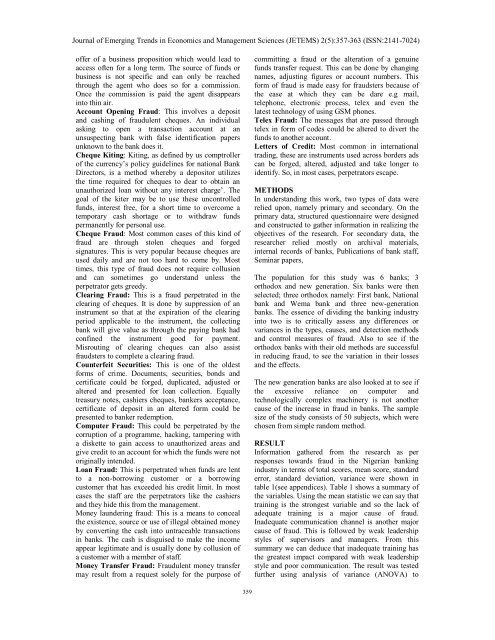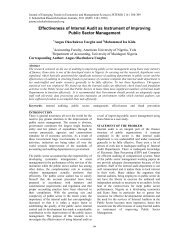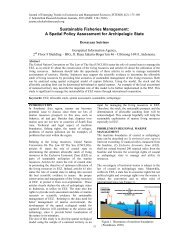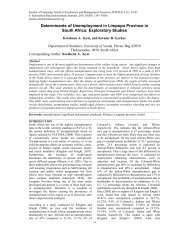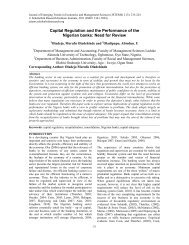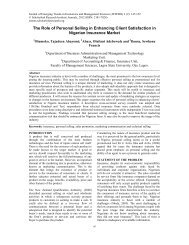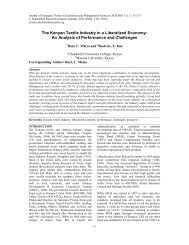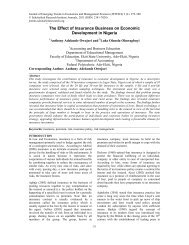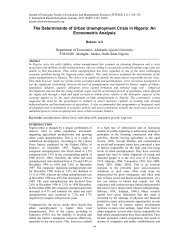Fraud as a Negative Catalyst in the Nigerian Banking Industry
Fraud as a Negative Catalyst in the Nigerian Banking Industry
Fraud as a Negative Catalyst in the Nigerian Banking Industry
Create successful ePaper yourself
Turn your PDF publications into a flip-book with our unique Google optimized e-Paper software.
Journal of Emerg<strong>in</strong>g Trends <strong>in</strong> Economics and Management Sciences (JETEMS) 2(5):357-363 (ISSN:2141-7024)offer of a bus<strong>in</strong>ess proposition which would lead toaccess often for a long term. The source of funds orbus<strong>in</strong>ess is not specific and can only be reachedthrough <strong>the</strong> agent who does so for a commission.Once <strong>the</strong> commission is paid <strong>the</strong> agent disappears<strong>in</strong>to th<strong>in</strong> air.Account Open<strong>in</strong>g <strong>Fraud</strong>: This <strong>in</strong>volves a depositand c<strong>as</strong>h<strong>in</strong>g of fraudulent cheques. An <strong>in</strong>dividual<strong>as</strong>k<strong>in</strong>g to open a transaction account at anunsuspect<strong>in</strong>g bank with false identification papersunknown to <strong>the</strong> bank does it.Cheque Kit<strong>in</strong>g: Kit<strong>in</strong>g, <strong>as</strong> def<strong>in</strong>ed by us comptrollerof <strong>the</strong> currency’s policy guidel<strong>in</strong>es for national BankDirectors, is a method whereby a depositor utilizes<strong>the</strong> time required for cheques to dear to obta<strong>in</strong> anunauthorized loan without any <strong>in</strong>terest charge’. Thegoal of <strong>the</strong> kiter may be to use <strong>the</strong>se uncontrolledfunds, <strong>in</strong>terest free, for a short time to overcome atemporary c<strong>as</strong>h shortage or to withdraw fundspermanently for personal use.Cheque <strong>Fraud</strong>: Most common c<strong>as</strong>es of this k<strong>in</strong>d offraud are through stolen cheques and forgedsignatures. This is very popular because cheques areused daily and are not too hard to come by. Mosttimes, this type of fraud does not require collusionand can sometimes go understand unless <strong>the</strong>perpetrator gets greedy.Clear<strong>in</strong>g <strong>Fraud</strong>: This is a fraud perpetrated <strong>in</strong> <strong>the</strong>clear<strong>in</strong>g of cheques. It is done by suppression of an<strong>in</strong>strument so that at <strong>the</strong> expiration of <strong>the</strong> clear<strong>in</strong>gperiod applicable to <strong>the</strong> <strong>in</strong>strument, <strong>the</strong> collect<strong>in</strong>gbank will give value <strong>as</strong> through <strong>the</strong> pay<strong>in</strong>g bank hadconf<strong>in</strong>ed <strong>the</strong> <strong>in</strong>strument good for payment.Misrout<strong>in</strong>g of clear<strong>in</strong>g cheques can also <strong>as</strong>sistfraudsters to complete a clear<strong>in</strong>g fraud.Counterfeit Securities: This is one of <strong>the</strong> oldestforms of crime. Documents, securities, bonds andcertificate could be forged, duplicated, adjusted oraltered and presented for loan collection. Equallytre<strong>as</strong>ury notes, c<strong>as</strong>hiers cheques, bankers acceptance,certificate of deposit <strong>in</strong> an altered form could bepresented to banker redemption.Computer <strong>Fraud</strong>: This could be perpetrated by <strong>the</strong>corruption of a programme, hack<strong>in</strong>g, tamper<strong>in</strong>g witha diskette to ga<strong>in</strong> access to unauthorized are<strong>as</strong> andgive credit to an account for which <strong>the</strong> funds were notorig<strong>in</strong>ally <strong>in</strong>tended.Loan <strong>Fraud</strong>: This is perpetrated when funds are lentto a non-borrow<strong>in</strong>g customer or a borrow<strong>in</strong>gcustomer that h<strong>as</strong> exceeded his credit limit. In mostc<strong>as</strong>es <strong>the</strong> staff are <strong>the</strong> perpetrators like <strong>the</strong> c<strong>as</strong>hiersand <strong>the</strong>y hide this from <strong>the</strong> management.Money launder<strong>in</strong>g fraud: This is a means to conceal<strong>the</strong> existence, source or use of illegal obta<strong>in</strong>ed moneyby convert<strong>in</strong>g <strong>the</strong> c<strong>as</strong>h <strong>in</strong>to untraceable transactions<strong>in</strong> banks. The c<strong>as</strong>h is disguised to make <strong>the</strong> <strong>in</strong>comeappear legitimate and is usually done by collusion ofa customer with a member of staff.Money Transfer <strong>Fraud</strong>: <strong>Fraud</strong>ulent money transfermay result from a request solely for <strong>the</strong> purpose ofcommitt<strong>in</strong>g a fraud or <strong>the</strong> alteration of a genu<strong>in</strong>efunds transfer request. This can be done by chang<strong>in</strong>gnames, adjust<strong>in</strong>g figures or account numbers. Thisform of fraud is made e<strong>as</strong>y for fraudsters because of<strong>the</strong> e<strong>as</strong>e at which <strong>the</strong>y can be dare e.g mail,telephone, electronic process, telex and even <strong>the</strong>latest technology of us<strong>in</strong>g GSM phones.Telex <strong>Fraud</strong>: The messages that are p<strong>as</strong>sed throughtelex <strong>in</strong> form of codes could be altered to divert <strong>the</strong>funds to ano<strong>the</strong>r account.Letters of Credit: Most common <strong>in</strong> <strong>in</strong>ternationaltrad<strong>in</strong>g, <strong>the</strong>se are <strong>in</strong>struments used across borders adscan be forged, altered, adjusted and take longer toidentify. So, <strong>in</strong> most c<strong>as</strong>es, perpetrators escape.METHODSIn understand<strong>in</strong>g this work, two types of data wererelied upon, namely primary and secondary. On <strong>the</strong>primary data, structured questionnaire were designedand constructed to ga<strong>the</strong>r <strong>in</strong>formation <strong>in</strong> realiz<strong>in</strong>g <strong>the</strong>objectives of <strong>the</strong> research. For secondary data, <strong>the</strong>researcher relied mostly on archival materials,<strong>in</strong>ternal records of banks, Publications of bank staff,Sem<strong>in</strong>ar papers,The population for this study w<strong>as</strong> 6 banks; 3orthodox and new generation. Six banks were <strong>the</strong>nselected; three orthodox namely: First bank, Nationalbank and Wema bank and three new-generationbanks. The essence of divid<strong>in</strong>g <strong>the</strong> bank<strong>in</strong>g <strong>in</strong>dustry<strong>in</strong>to two is to critically <strong>as</strong>sess any differences orvariances <strong>in</strong> <strong>the</strong> types, causes, and detection methodsand control me<strong>as</strong>ures of fraud. Also to see if <strong>the</strong>orthodox banks with <strong>the</strong>ir old methods are successful<strong>in</strong> reduc<strong>in</strong>g fraud, to see <strong>the</strong> variation <strong>in</strong> <strong>the</strong>ir lossesand <strong>the</strong> effects.The new generation banks are also looked at to see if<strong>the</strong> excessive reliance on computer andtechnologically complex mach<strong>in</strong>ery is not ano<strong>the</strong>rcause of <strong>the</strong> <strong>in</strong>cre<strong>as</strong>e <strong>in</strong> fraud <strong>in</strong> banks. The samplesize of <strong>the</strong> study consists of 50 subjects, which werechosen from simple random method.RESULTInformation ga<strong>the</strong>red from <strong>the</strong> research <strong>as</strong> perresponses towards fraud <strong>in</strong> <strong>the</strong> <strong>Nigerian</strong> bank<strong>in</strong>g<strong>in</strong>dustry <strong>in</strong> terms of total scores, mean score, standarderror, standard deviation, variance were shown <strong>in</strong>table 1(see appendices). Table 1 shows a summary of<strong>the</strong> variables. Us<strong>in</strong>g <strong>the</strong> mean statistic we can say thattra<strong>in</strong><strong>in</strong>g is <strong>the</strong> strongest variable and so <strong>the</strong> lack ofadequate tra<strong>in</strong><strong>in</strong>g is a major cause of fraud.Inadequate communication channel is ano<strong>the</strong>r majorcause of fraud. This is followed by weak leadershipstyles of supervisors and managers. From thissummary we can deduce that <strong>in</strong>adequate tra<strong>in</strong><strong>in</strong>g h<strong>as</strong><strong>the</strong> greatest impact compared with weak leadershipstyle and poor communication. The result w<strong>as</strong> testedfur<strong>the</strong>r us<strong>in</strong>g analysis of variance (ANOVA) to359


